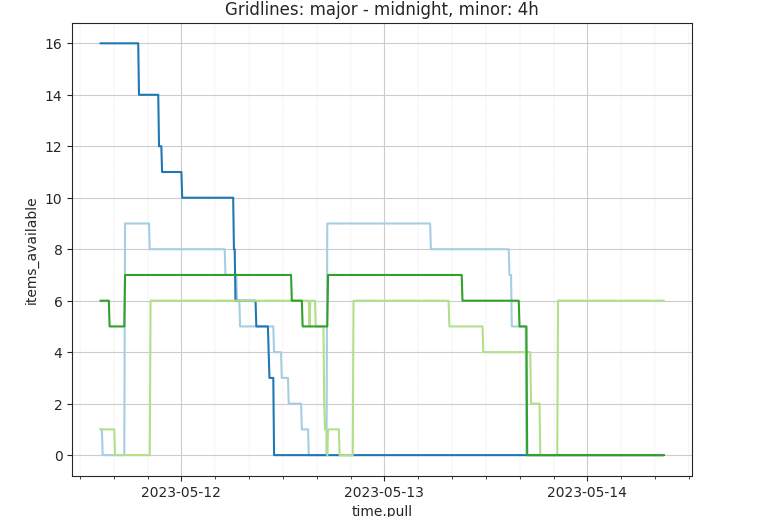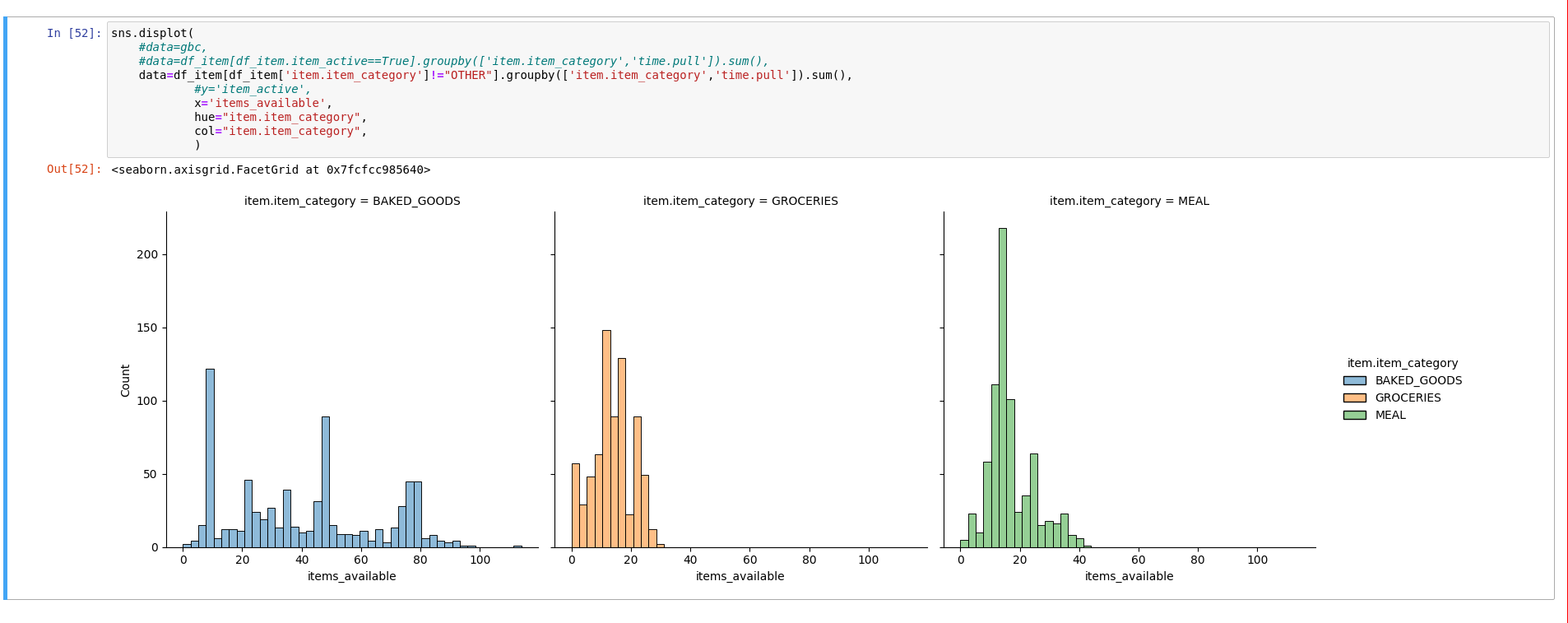serhii.net
In the middle of the desert you can say anything you want
-
Day 1596 (16 May 2023)
matplotlib datetime axes indexing
If you have an axis indexed from timestamps and want to draw stuff there, you need to convert between datetimes and coordinates.
SO1 led me to matplotlib.dates — Matplotlib 3.7.1 documentation.
from matplotlib.dates import date2num coordinate_float_value = date2num(your_timestamp) # there's also num2date, etc.Then you can do things like
g=sns.histplot(...) g.axes.bar(x=date2num(timestamp),height=5,width=0.01) #orRef:
- matplotlib.axes.Axes.bar — Matplotlib 3.7.1 documentation
- matplotlib.dates — Matplotlib 3.7.1 documentation
And, for later, gridlnes/dates fun I’ll document later maybe:
from matplotlib.dates import date2num, drange from datetime import timedelta import matplotlib.ticker as ticker g = sns.lineplot(...) # We create a grid located at midnight of each day t_end = df_item['time.pull'].max().ceil(freq="D") t_start = df_item['time.pull'].min().floor(freq="D") dr_days = drange(t_start,t_end,delta=timedelta(days=1)) dr_hours = drange(t_start,t_end,delta=timedelta(hours=4)) g.axes.grid(True, axis='both',which='major') g.axes.grid(True, axis='both',which='minor',linewidth=0.2,linestyle="--") g.axes.xaxis.set_major_locator(ticker.FixedLocator(dr_days)) g.axes.xaxis.set_minor_locator(ticker.FixedLocator(dr_hours))
-
Day 1595 (15 May 2023)
Seaborn setting titles and stuff through matplotlib's axis .set() function
For titles I was using
sns.histplot(..).set(title="My title"), but I couldn’t find any documentation for that.set()function in the seaborn docu.Seaborn’s FAQ (“How can I can I change something about the figure?”) led me here: matplotlib.axes.Axes.set — Matplotlib 3.7.1 documentation
It’s actually a matplotlib function!
(TODO: understand much better how seaborn exposes matplotlib’s internals. Then I can google for matplotlib stuff too)
Bonus: setting figure title for each facet of a FacetGrid AND the entire figure
You can access the matplotlib
Figurethrough.fig, then use matplotlib.pyplot.suptitle — Matplotlib 3.7.1 documentation for the main figure title!x = sns.displot( data=xxx, x='items_available', col="item.item_category", ).set_titles(col_template="{col_name}") # Title template for each facet # Main figure title, through matplotlib Figure x.fig.suptitle("Distribution of sums of all items_available per time.pull",va='bottom')
Pandas joining and merging tables
I was trying to do a join based on two columns, one of which is a pd
Timestamp.What I learned: If you’re trying to join/merge two DataFrames not by their indexes,
pandas.DataFrame.merge is better (yay precise language) than pandas.DataFrame.join.Or, for some reason I had issues with
df.join(.. by=[col1,col2]), even withdf.set_index([col1,col2]).join(df2.set_index...), then it went out of memory and I gave up.Then a SO answer1 said
use merge if you are not joining on the index
I tried it and
df.merge(..., by=col2)magically worked!
seaborn things built on FacetGrid for easy multiple plots
This is REALLY neat and seaborn is now officially the best thing since sliced bread (only having pie charts could make it better1).
seaborn.FacetGrid — seaborn 0.12.2 documentation:
relplot Combine a relational plot and a FacetGrid
displot Combine a distribution plot and a FacetGrid
catplot Combine a categorical plot and a FacetGrid
lmplot Combine a regression plot and a FacetGrid

sns.displot( data=df_item[df_item['item.item_category']!="OTHER"].groupby(['item.item_category','time.pull']).sum(), #y='item_active', x='items_available', hue="item.item_category", col="item.item_category", )All of this takes
row/colarguments that neatly create separate plots!
-
Obyde/obsidian internal link test: 230515-1855 Pie charts considered harmful ↩︎
Pandas categorical types weirdness
Spent hours trying to understand what’s happening.
TL;DR categorical types inside groupbys get shown ALL, even if there are no instances of a specific type in the actual data.
# Shows all categories including OTHER df_item[df_item['item.item_category']!="OTHER"].groupby(['item.item_category']).sum() df_item['item.item_category'] = df_item['item.item_category'].astype(str) # Shows three categories df_item[df_item['item.item_category']!="OTHER"].groupby(['item.item_category']).sum()Rel. thread: groupby with categorical type returns all combinations · Issue #17594 · pandas-dev/pandas
Pandas seaborn plotting groupby can be used without reset_index
Both things below work! Seaborn is smart and parses pd groupby-s as-is
sns.histplot(data=gbc, x='items_available', hue="item.item_category", ) sns.histplot(data=gbc.reset_index(), x='items_available', hue="item.item_category", )
Pie Charts Considered Harmful
Note that seaborn doesn’t create pie charts, as seaborn’s author considers those to be unfit for statistical visualization. See e.g. Why you shouldn’t use pie charts – Johan 1
Why you shouldn’t use pie charts:
Pies and doughnuts fail because:
- Quantity is represented by slices; humans aren’t particularly good at estimating quantity from angles, which is the skill needed.
- Matching the labels and the slices can be hard work.
- Small percentages (which might be important) are tricky to show.

The world is interesting.
Pandas set column value based on (incl.groupby) filter
TL;DR
df.loc[row_indexer, col_indexer] = valuecol_indexercan be a non-existing-yet column! Androw_indexercan be anything, including based on agroupbyfilter.Below, the groupby filter has
dropna=Falsewhich would return also the rows that don’t match the filter, giving a Series with the same indexes as the main df# E.g. this groupby filter - NB. dropna=False df_item.groupby(['item.item_id']).filter(lambda x:x.items_available.max()>0, dropna=False)['item.item_id'] # Then we use that in the condition, nice arbitrary example with `item.item_id` not being the index of the DF df_item.loc[df_item['item.item_id']==df_item.groupby(['item.item_id']).filter(lambda x:x.items_available.max()>0, dropna=False)['item.item_id'],'item_active'] = TrueI’m not sure whether this is the “best” way to incorporate groupby results, but seems to work OK for now.
Esp. the remaining rows have
naninstead of False, can be worked around but is ugly:df_item['item_active'] = df_item['item_active'].notna() # For plotting purposes sns.histplot(data=df_item.notna(), ... )Pandas Filter by Column Value - Spark By {Examples} has more examples of conditions:
# From https://sparkbyexamples.com/pandas/pandas-filter-by-column-value/ df.loc[df['Courses'] == value] df.loc[df['Courses'] != 'Spark'] df.loc[df['Courses'].isin(values)] df.loc[~df['Courses'].isin(values)] df.loc[(df['Discount'] >= 1000) & (df['Discount'] <= 2000)] df.loc[(df['Discount'] >= 1200) & (df['Fee'] >= 23000 )] df[df["Courses"] == 'Spark'] df[df['Courses'].str.contains("Spark")] df[df['Courses'].str.lower().str.contains("spark")] df[df['Courses'].str.startswith("P")]
-
-
Day 1591 (11 May 2023)
jupyter pandas interactive tables
mwouts/itables: Pandas DataFrames as Interactive DataTables:
from itables import init_notebook_mode init_notebook_mode(all_interactive=True)It kept “loading”. I set the notebook to ’trusted’ as per help, didn’t help.
But this did:
init_notebook_mode(all_interactive=True, connected=True)(
connected=Truemakes it load libraries dynamically from the internet, and is not the default)Allows more interesting interactive dynamical tables. Incl. things like sorting by column etc.
Pandas add colums to dataframe based on dictionary inside a column
Courtesy of ChatGPT, after googling for 15 minutes didn’t bring anything immediately copy-pasteable.
I’ll deal with the existential crisis from this later.
To explode the cells containing dictionaries in a pandas DataFrame and append them as additional columns, you can use the apply() method along with the pd.Series() constructor. Here’s an example:
import pandas as pd # create example DataFrame df = pd.DataFrame({ 'id': [1, 2], 'info': [ {'name': 'Alice', 'age': 25}, {'name': 'Bob', 'age': 30, 'city': 'New York'} ] }) # use apply() with pd.Series() to explode the dictionaries and append them as columns df = pd.concat([df.drop('info', axis=1), df['info'].apply(pd.Series)], axis=1) print(df)Output:
id name age city 0 1 Alice 25 NaN 1 2 Bob 30 New YorkIn this example, we first create a DataFrame with two rows, where the info column contains dictionaries. We then use the apply() method with pd.Series() to explode the dictionaries and create additional columns for each key in the dictionaries. Finally, we concatenate the exploded columns with the original DataFrame using pd.concat().